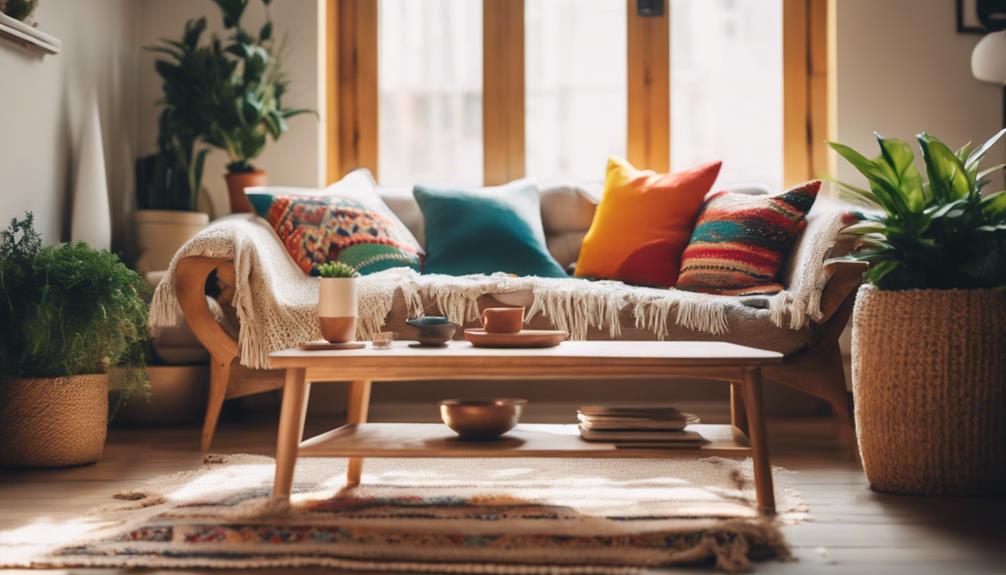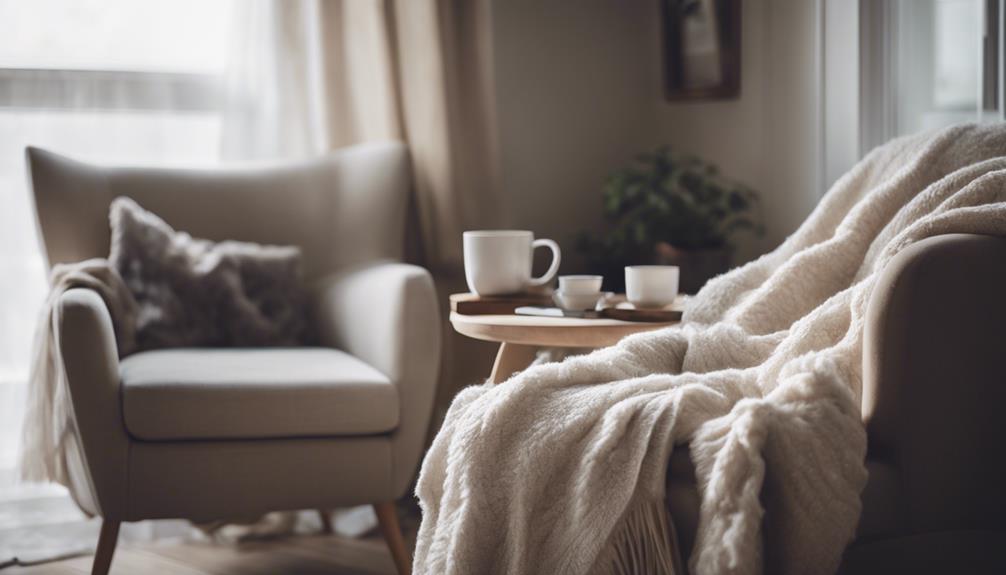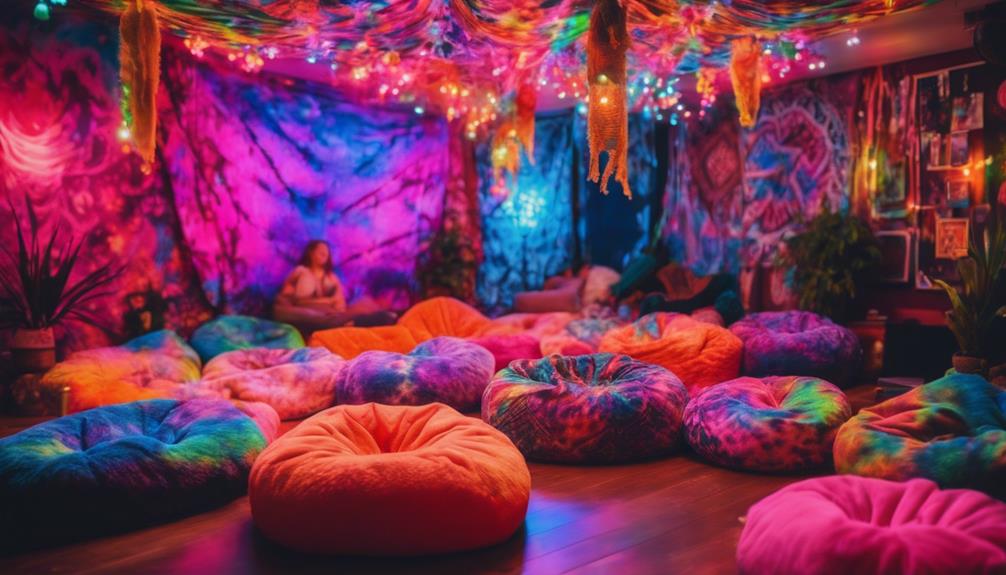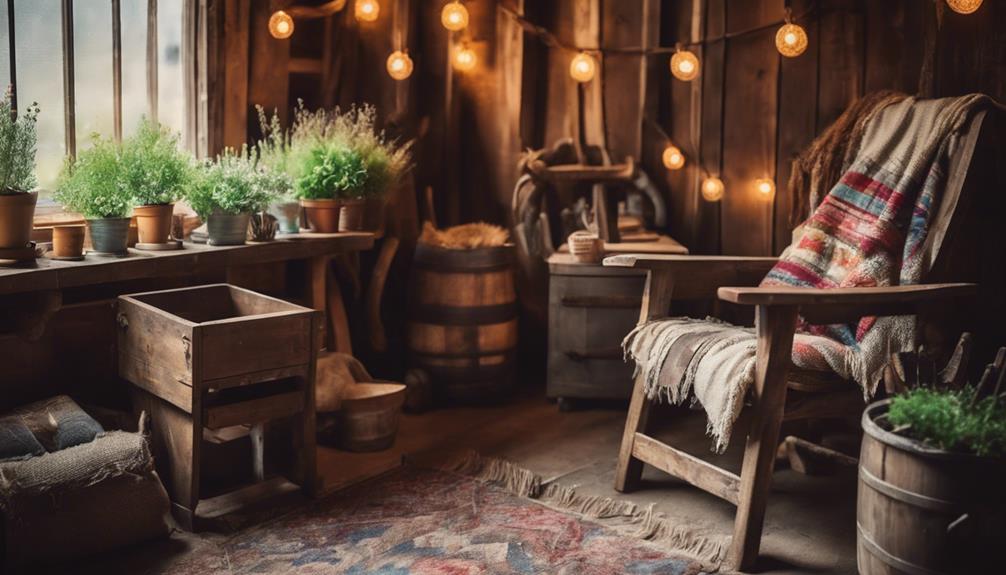You can effortlessly blend Scandinavian simplicity and Bohemian warmth to create a fresh, inviting space that feels both stylish and comfortable. Start with a neutral palette of whites and grays, then add vibrant accents through textiles and decor. Incorporate natural materials like wood and soft linens for warmth. Layer rugs and mix textures using cushions and throws to enhance coziness. Key pieces like a vintage coffee table and a macrame wall hanging can tie it all together. To elevate your design, focus on unique lighting and decorative elements that reflect both styles. There's so much more you can explore to make your space uniquely yours!
Key Elements
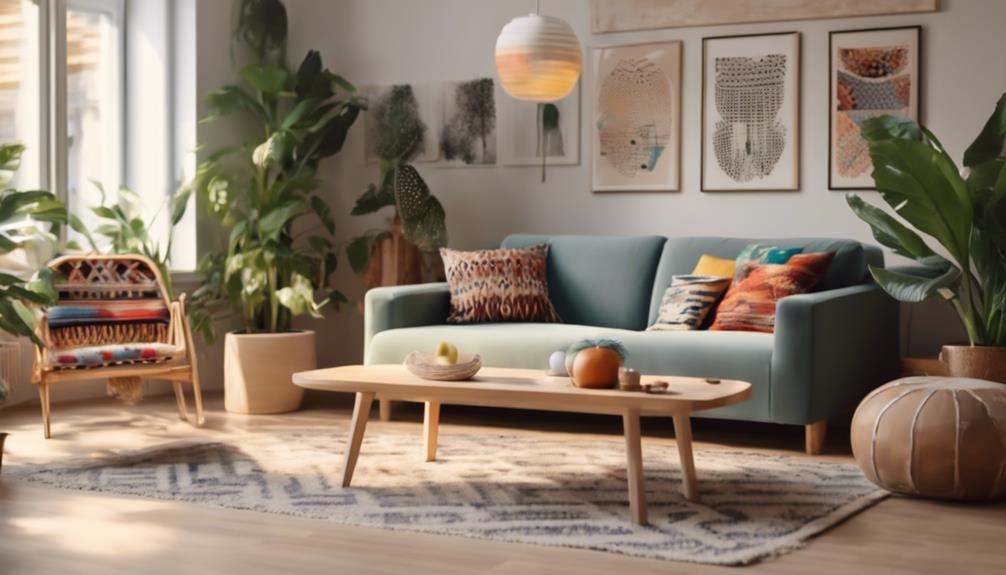
When blending Scandinavian and Bohemian styles, you'll want to focus on your color scheme, materials, and textures. For the color scheme, consider incorporating light, neutral tones like white, cream, and beige with pops of warm, earthy shades like terracotta and mustard. When it comes to materials, prioritize natural elements like wood, rattan, and leather to bring warmth and coziness to the space. Emphasize textures by mixing in soft, plush textiles like sheepskin and chunky knit blankets. For functional art ideas for scandi decor, consider incorporating pieces like geometric shelving, minimalist wall hangings, and handcrafted ceramics to add a personal touch and visual interest to the room.
A neutral base allows for vibrant accents, while natural materials like wood and leather bring warmth.
Layering textures with rugs and cushions adds comfort and visual interest to your space.
Color Scheme
To achieve a harmonious color scheme in Scandinavian and Bohemian styles, start with a neutral base of whites and grays that sets a bright, airy backdrop for your space. This foundation allows other design elements to shine without feeling cluttered.
From there, introduce vibrant accent colors through textiles, décor, and artwork. These pops of color add personality and warmth, but make sure they complement rather than overwhelm your neutral palette.
Utilizing muted color palettes featuring earthy tones can also promote a relaxed environment, aligning perfectly with the bohemian emphasis on comfort and tranquility.
Don't hesitate to experiment with layering different shades of the same color; this technique creates depth and visual interest while maintaining a cohesive look throughout the room.
Materials
Embrace natural materials like wood, leather, and organic textiles to create a warm and inviting atmosphere that embodies both Scandinavian and Bohemian styles. These materials not only enhance the aesthetic but also foster a sense of sustainability.
Consider incorporating sustainable elements like recycled or reclaimed wood; this choice aligns with both design philosophies while promoting environmental responsibility.
In your space, opt for soft linens and cozy wool to complement the rustic allure of jute. Each of these fabrics adds depth and comfort, making your home feel more lived-in and welcoming.
Vintage and artisanal decor items, such as handcrafted ceramics and handwoven textiles, are essential in Bohemian design. They introduce character and uniqueness against the minimalist Scandinavian backdrop.
Don't forget to integrate greenery into your design. Potted plants and hanging foliage not only elevate the visual appeal but also improve indoor air quality, connecting your living space to nature.
Textures
Incorporating a variety of natural fabrics like linen, cotton, and wool enriches the tactile experience of your space, adding warmth and comfort. These materials not only complement the Scandinavian aesthetic but also embrace the free-spirited essence of bohemian style.
To enhance the coziness, layer rugs made from different materials like jute, sheepskin, and cotton. This creates depth and comfort underfoot while bringing visual interest to your room.
Mix cushions and throws in diverse textures—think fringed, knitted, and fluffy options—to foster an inviting atmosphere. These elements invite relaxation and add a personal touch that embodies the bohemian spirit.
Don't forget to select sculptural lighting fixtures featuring organic shapes and mixed materials; they inject character and dimension into your design.
Layering is essential in achieving a dynamic environment. Use plants and decorative objects at varying heights to create visual intrigue and balance.
Essential Fixtures and Furniture
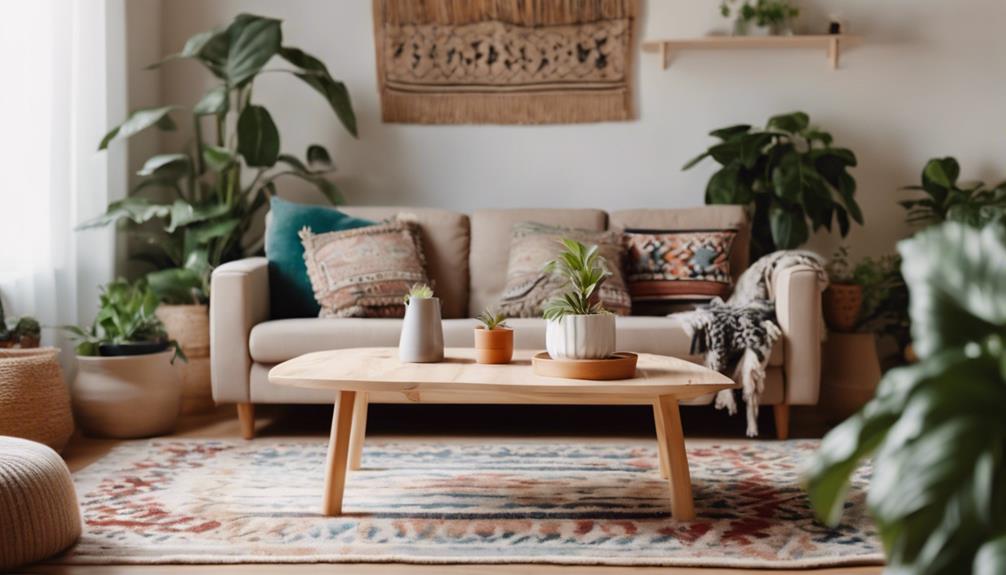
To create a harmonious blend of Scandinavian and Bohemian styles, you'll want to incorporate essential fixtures like a vintage Scandinavian coffee table that adds character and practicality.
Pair it with a macrame wall hanging for an artistic touch, and consider a hanging rattan chair for that cozy, laid-back vibe.
These pieces not only enhance your space but also reflect the unique charm of each style.
Vintage Scandinavian Coffee Table
Choosing a vintage Scandinavian coffee table brings together functionality and rustic charm, making it a striking centerpiece for your living space.
These tables often showcase clean lines and minimalistic design, embodying the principles of Scandinavian simplicity while infusing a cozy, bohemian vibe. Crafted from sustainable materials like solid wood, they not only guarantee durability but also resonate with eco-conscious living—a key aspect of the Bohemian ethos.
The versatility of a vintage Scandinavian coffee table allows it to seamlessly blend with various interior styles, enhancing both traditional and modern spaces. Each piece features unique patinas and craftsmanship, adding character and telling a story that celebrates individuality in your décor.
When styling your vintage Scandinavian coffee table, think about layering textures to create an inviting focal point. Use decorative trays, stack a few books, and incorporate greenery to bring life to the arrangement.
This approach not only highlights the table's beauty but also enhances the cozy atmosphere you aim for in a boho-inspired living area. Embrace the charm of a vintage Scandinavian coffee table, and watch how it transforms your space into a warm, welcoming haven.
Macrame Wall Hanging
Macrame wall hangings beautifully complement the rustic charm of a vintage Scandinavian coffee table, adding texture and artistry to your living space.
These stunning pieces not only enhance the aesthetic appeal but also blend the intricate craftsmanship of bohemian design with the clean lines typical of Scandinavian style. In minimalist settings, macrame wall hangings can serve as focal points, providing warmth and a cozy atmosphere.
Opt for macrame wall hangings in neutral tones to maintain the light, airy feel of Scandinavian interiors while introducing a unique, handcrafted element. You can also incorporate macrame in various forms, such as plant hangers, which bring greenery into your home, connecting you with nature. This promotes a vibrant, invigorating ambiance that uplifts your space.
The versatility of macrame allows it to be styled in multiple ways, whether as a statement piece above your sofa or layered with other wall decor.
Hanging Rattan Chair
A hanging rattan chair instantly transforms any corner of your home into a cozy retreat, blending bohemian flair with Scandinavian simplicity. This stylish centerpiece not only creates a perfect nook for relaxation but also adds an organic texture to your decor. The lightweight and flexible nature of rattan makes it an ideal material for these chairs, complementing the minimalist ethos of Scandinavian design while embracing the free-spirited essence of bohemian style.
You can suspend a hanging rattan chair from ceilings or sturdy frames, making it an inviting focal point that encourages playfulness and comfort in your living area. With intricate woven patterns, these chairs enhance visual interest and provide a tactile experience, aligning seamlessly with the boho aesthetic of layering textures and materials.
Incorporating a hanging rattan chair into your space promotes mindfulness and relaxation, echoing the Scandinavian philosophy of lagom. It helps create a balanced and serene environment, allowing you to unwind and enjoy the moment.
Lighting Ideas
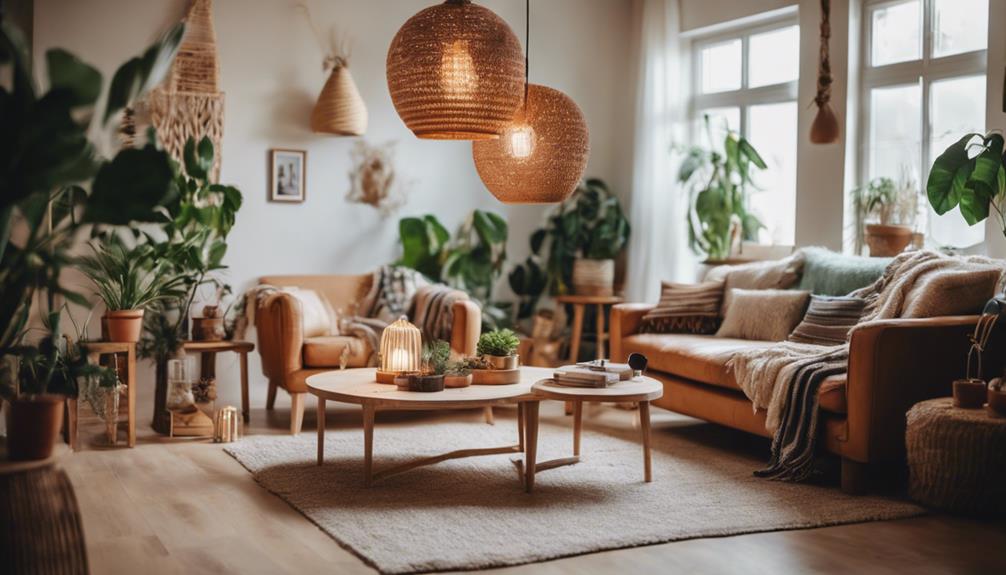
When it comes to lighting, you can really enhance your space with unique fixtures that reflect both Scandinavian and Bohemian styles.
Think about incorporating a hanging beaded light fixture or a handcrafted ceramic table lamp to add warmth and character.
Don't forget a geometric floor lamp or vintage glass pendant light to complete the eclectic yet cohesive look you're aiming for.
Hanging Beaded Light Fixture
Incorporating a hanging beaded light fixture instantly infuses your space with a bohemian flair while keeping the sleek lines typical of Scandinavian design. This unique lighting choice merges both styles effectively, creating an inviting atmosphere that encourages comfort and interaction, especially in living areas.
Often crafted from natural materials like wood, rattan, or metal, these fixtures align perfectly with the eco-conscious ethos of both Scandinavian and boho aesthetics. You'll find that the soft, diffused lighting from a hanging beaded light fixture enhances the warmth of your home, making it feel more welcoming to guests.
What's great is the variety of designs available, allowing you to personalize your choice and incorporate unique patterns that reflect your individual style and cultural influences. Whether you opt for a minimalist look or something more intricate, a hanging beaded light fixture can serve as a stunning focal point in your decor.
It draws attention without overwhelming your space, adding depth and character while maintaining a harmonious balance between rustic charm and modern simplicity. Embrace the blend of these styles and watch your space transform!
Handcrafted Ceramic Table Lamp
Handcrafted ceramic table lamps elevate your space with an artisanal touch that beautifully complements both Scandinavian and Bohemian styles. These unique lamps often showcase distinct glazes and textures, turning each piece into a work of art that reflects your personal style.
When you're selecting a handcrafted ceramic table lamp, look for options featuring organic shapes and earthy tones. This aligns perfectly with the natural materials emphasized in both design philosophies.
Incorporating a handcrafted ceramic table lamp can create a warm, inviting ambiance, contributing to the cozy atmosphere that's characteristic of Scandi-boho interiors. You'll find that these lamps not only serve as excellent light sources but also double as decorative statement pieces that enhance your room's overall aesthetic.
Consider placing a handcrafted ceramic table lamp on a side table or your nightstand to add a touch of elegance and warmth. Whether you opt for a minimalist design or something more intricately detailed, these lamps will effectively bridge the gap between the clean lines of Scandinavian design and the eclectic vibe of Bohemian decor.
Embrace the beauty and functionality of handcrafted ceramic table lamps to elevate your interior style.
Geometric Floor Lamp
Transforming your living space, a geometric floor lamp can become a striking focal point that beautifully merges Scandinavian simplicity with Bohemian artistry. These lamps typically feature clean lines and unique shapes, allowing you to add a touch of artistic flair while maintaining a minimalist aesthetic.
When choosing geometric floor lamps, look for options made from natural materials like wood or metal. This choice not only aligns with the eco-conscious values of both styles but also enhances the overall texture of your space. Interesting patterns and shapes in the lamp design can introduce depth and visual interest, making your room feel more inviting.
Additionally, consider adjustable or multi-functional geometric floor lamps. They enhance practicality while perfectly balancing the functional aspect of Scandinavian design with the eclectic vibe of Bohemian style. Pair your lamp with warm-toned bulbs to create a cozy atmosphere, fostering an inviting environment that encourages relaxation and connection.
With the right geometric floor lamp, you can effortlessly blend the elegance of Scandinavian design with the warmth of Bohemian aesthetics, giving your home a fresh and harmonious look.
Vintage Glass Pendant Light
Vintage glass pendant lights add a unique charm to your space, blending nostalgia with artistic flair that enhances both Scandinavian and Bohemian designs. With their intricate designs and unique shapes, these lights serve as stunning statement pieces that draw the eye and create focal points in any room. They complement the clean lines typical of Scandinavian decor while also embracing the eclectic essence of Bohemian style.
Choosing warm-toned glass can further improve the cozy and inviting atmosphere that characterizes both aesthetics, promoting a sense of warmth and comfort. When you incorporate vintage glass pendant lights, you're not just adding illumination; you're infusing your space with personality and style.
These lights are often made from sustainable materials, aligning perfectly with the eco-conscious ethos of the Boho-Scandi aesthetic. Their varied textures contribute to the layered look that's so favored in these designs.
As you select vintage glass pendant lights, consider their scale and placement to guarantee they balance with other elements in your space, enhancing harmony without overwhelming your decor. This thoughtful approach will help you achieve a fresh, integrated look that beautifully marries both styles.
Decorative Elements
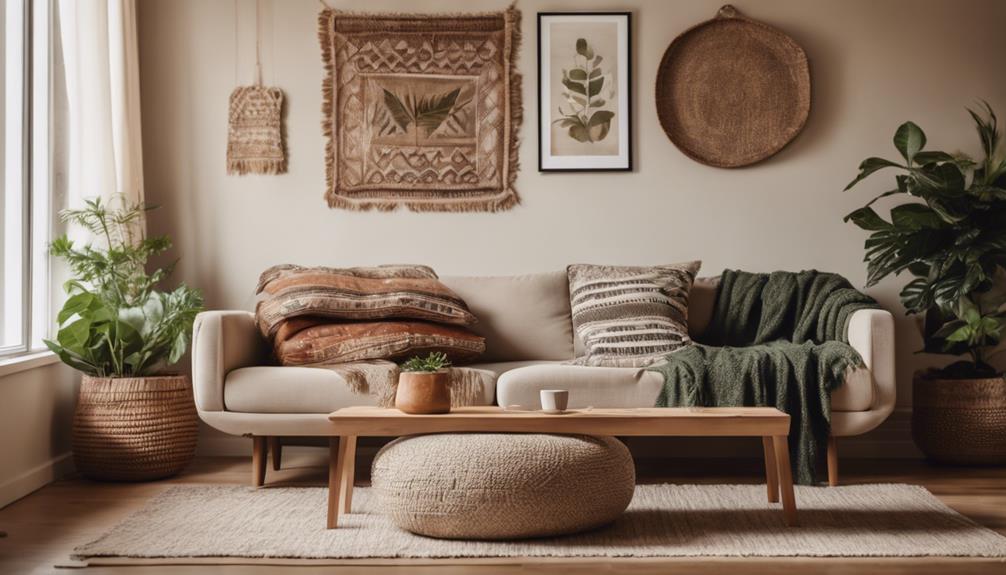
When you think about decorative elements, consider how a fringed textile wall hanging can add texture and warmth to your space.
A macrame plant hanger not only showcases your greenery but also brings a touch of artistry.
Pair these with a handwoven jute wall basket for an eclectic yet cohesive look that embodies both Scandinavian simplicity and Bohemian flair.
Fringed Textile Wall Hanging
Fringed textile wall hangings bring texture and warmth to your space, perfectly blending the organic charm of bohemian design with the clean lines of Scandinavian aesthetics.
These decorative elements are crafted from natural fibers like cotton, wool, or jute, aligning beautifully with the sustainable principles of both styles. When you incorporate a fringed wall hanging, you create a stunning focal point that enhances the layered visual interest typical of bohemian decor.
With a variety of colors and patterns available, fringed textile wall hangings can complement the neutral palettes often found in Scandinavian interiors while introducing a lively bohemian vibrancy. You can easily mix and match these textiles to suit your taste, adding depth and dimension to your walls.
Hanging them at varying heights not only creates visual interest but also effectively merges the minimalist approach of Scandinavian design with the eclectic spirit of bohemian style.
Incorporating fringed textile wall hangings into your home decor makes your space feel cozy and inviting, showcasing a unique blend of two beloved design aesthetics.
Macrame Plant Hanger
Incorporating macrame plant hangers into your decor instantly adds a tactile and artistic touch, merging the handcrafted charm of bohemian style with the natural elegance characteristic of Scandinavian design. These hangers, often made from eco-friendly cotton or jute, align perfectly with sustainable design practices cherished in both aesthetics.
By elevating your greenery, macrame plant hangers create visual interest and draw the eye upward. This not only enhances the perception of space and light in your room but also promotes a sense of airiness. You'll find them in various styles and sizes, allowing you to express your personal taste while maintaining a cohesive look in your Scandi-boho inspired interior.
Moreover, incorporating macrame plant hangers contributes to the philosophy of lagom, which emphasizes balance and moderation. By thoughtfully arranging these hangers, you can achieve a harmonious blend of textures and elements that reflect both styles.
Handwoven Jute Wall Basket
Handwoven jute wall baskets enhance your decor with their natural texture and warmth, perfectly complementing the macrame plant hangers and other elements in a Scandi-boho space. These eco-friendly decorative elements embody the sustainable ethos of both Scandinavian and Bohemian design, as jute is a natural and biodegradable material.
When you incorporate handwoven jute wall baskets, you not only add visual interest but also create a cozy atmosphere that aligns with the hygge philosophy prevalent in Scandinavian interiors. The intricate patterns and organic shapes of these baskets can serve as focal points, enhancing the eclectic aesthetic typical of Bohemian style.
Available in various sizes and designs, handwoven jute wall baskets can be used for storage or purely decorative purposes, allowing for both functionality and artistic expression. You'll find that these baskets harmonize the minimalist Scandinavian approach with the free-spirited essence of bohemian decor, creating a balanced and inviting environment.
Flooring

When it comes to flooring, you'll want to contemplate options that reflect both Scandinavian simplicity and Bohemian warmth.
Reclaimed wood planks and natural stone tiles can create a strong foundation, while cork flooring paired with patterned rugs adds both comfort and character.
Let's explore how these choices enhance the overall aesthetic of your space.
Reclaimed Wood Plank Flooring
Reclaimed wood plank flooring not only repurposes old materials but also brings a unique charm that enhances the cozy and eclectic vibes of Scandinavian and Bohemian styles. Choosing this sustainable option means you're reducing the demand for new lumber, which helps minimize your environmental impact. Each plank showcases natural variations in color and texture, adding character and warmth to your space.
With its rustic appeal, reclaimed wood flooring aligns perfectly with the hygge principles of Scandinavian design, emphasizing comfort and well-being. It creates a cozy atmosphere where you can relax and unwind. At the same time, this type of flooring serves as a grounding base for the eclectic elements of Bohemian style, harmonizing various decor styles and textures in your home.
Additionally, installing reclaimed wood planks can enhance your indoor air quality, often being free from harmful chemicals found in many manufactured flooring options. This promotes a healthier living environment, allowing you to breathe easy while enjoying the beauty of your space.
Natural Stone Tile Flooring
Natural stone tile flooring transforms your space with its unique aesthetic, perfectly blending the rustic charm of Bohemian style and the sleek minimalism of Scandinavian design. Available in various types like slate, limestone, and travertine, natural stone tiles introduce organic textures and earthy tones that complement the neutral palettes typical of Scandi-boho designs.
This flooring option isn't just beautiful; it's also durable and low maintenance, making it ideal for high-traffic areas. You'll enjoy the functional beauty that supports the practical aspects of Scandinavian interiors. Plus, incorporating natural stone tiles can create a seamless indoor-outdoor flow, especially when paired with greenery and large windows that enhance the light-filled spaces characteristic of both styles.
The tactile quality of natural stone flooring adds visual interest while promoting warmth underfoot, contributing to the cozy, inviting atmosphere essential to Bohemian aesthetics.
Whether you're looking to create a serene retreat or an eclectic gathering space, natural stone tile flooring serves as a versatile foundation that elevates your design, harmonizing the best of both worlds.
Consider this option for a fresh, cohesive look in your home!
Cork Flooring With Patterned Rugs
Cork flooring offers an eco-friendly foundation that beautifully complements the vibrant patterns of rugs, enhancing the cozy aesthetic of both Scandinavian and Bohemian styles. Its warm, neutral tones create a soothing backdrop, allowing your colorful patterned rugs to become focal points in your space.
You'll find that the durability and natural insulation of cork flooring provide a comfortable living environment, essential for both styles. Layering bold patterned rugs over cork flooring adds visual interest and warmth, perfectly embodying the eclectic spirit of Bohemian decor.
The natural texture of cork pairs well with various rug materials, like wool and jute, emphasizing the organic and tactile qualities of Scandi-boho design. This combination not only promotes a harmonious balance of comfort and style but also invites a welcoming atmosphere into your home.
When selecting rugs, consider how their patterns and colors will interact with the cork flooring. This thoughtful pairing can transform your living space into a cozy retreat that reflects your unique taste while blending these two styles seamlessly.
Enjoy the inviting warmth underfoot and the stunning aesthetics that come from combining cork flooring with patterned rugs.
Conclusion
By blending Scandinavian and Bohemian styles, you can create a fresh and inviting space that reflects your personality.
Embrace the clean lines and minimalism of Scandinavian design while incorporating the vibrant colors and eclectic elements of Bohemian flair.
With carefully chosen fixtures, unique lighting, and thoughtful decorative accents, you'll transform your home into a cozy yet stylish retreat.
So go ahead, mix and match these styles to achieve a look that's uniquely yours!
